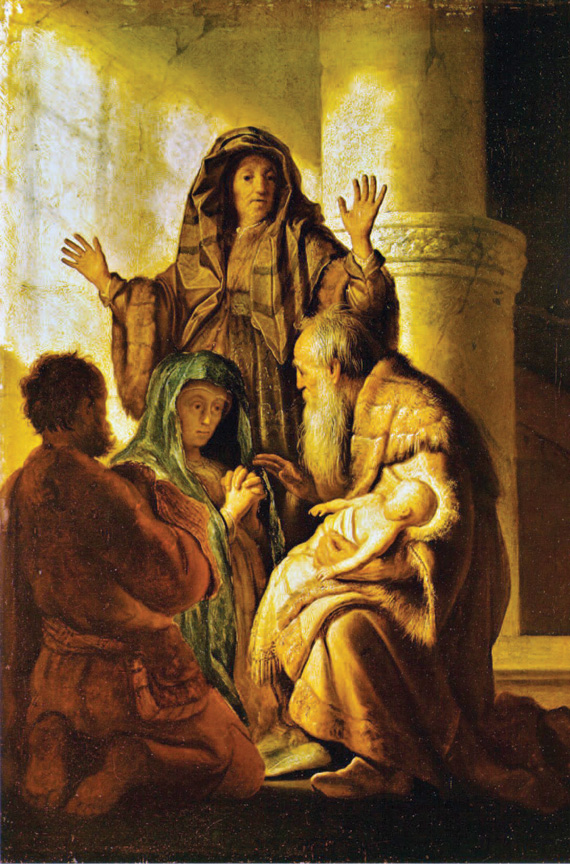Azadi ka Amrit Mahotsav Kolkata event honours four Clergymen
Pope Francis asks businesses to support working women: They’re ‘afraid to get pregnant’
Study: Christianity may lose majority, plurality status in U.S. by 2070
Indian politician declines Magsaysay Award under party pressure
Like John Paul II, Pope Francis heads to Kazakhstan during time of war

Benny Nalkara, CMI
The evangelist Luke is fond of pairing male and female figures in the narratives and makes the balance of parallel figures. We have the examples of Zechariah and Elizabeth (Lk 1:5-38) and Simeon and Anna (Lk 2:22-38). In prophetesses Anna, Luke gives testimony of a pious woman to the salvation God brought in Jesus Christ (Lk 2:36-38). She is presented as a witness to the fulfilment of God’s promise at the time of the presentation of the child Jesus by Joseph and Mary in the Jerusalem temple. Like Simeon, the role of Anna is clearly presented by Luke- the recognition of the Saviour.
The name Hannah or Anna means “grace.” Anna’s activity depicts her as a person totally focussed on serving God and her presence was a graceful one to all. Her deep passion for God was behind her prophetic inspiration. Anna was a descendant of the family from the Northern Kingdom, the daughter of Phanuel, in the tribe of Asher. Phanuel calls to mind the name Peniel (“face of God”), given by Jacob to the place where in the night he had his inner struggle with the angel (Gen 32:31). The tribe of Asher, in turn, evokes a prestigious ancestor, namely the son of the Matriarch Leah (Gen 30:13). From the narrative we understand that she became a widow after seven years of her marriage. The mentioning about her age ambiguous: it could mean that she was 84 years old, or that she had been a widow for 84 years. Some scholars consider the latter to be the more likely option.
In Jewish tradition seven women are mentioned as prophetesses: Sarah, Miriam, Deborah, Hannah, Abigail, Huldah and Esther. Of these, Miriam (Ex. 15:20), Deborah (Judg 4:4) and Huldah (2 Kings 22:14) together with Noadiah (Neh 6:14) and Isaiah’s wife (Isa 8:3) are portrayed as prophetesses in the Old Testament. Anna, the prophetess is a recognized as the interpreter of God’s will for Israel in the New Testament continues the tradition of these female prophets in the OT and anticipates the role of the female prophets in the early Church (Act 2:17; 21:9; 1 Cor 11:5). Anna exemplifies the pious widow in both Judaism (Jdt 8:1) and in the early Church (1 Tim 5:5, 9-10). She was capable of recognizing the true identity of Jesus. Anna, unlike Simeon, does not burst into a hymn of praise in which Israel’s messianic hopes are mentioned and celebrated, but shares fully in this gaze which is born from the depths of her faith. Anna’s blessing consists of praising God and of speaking of the Child “to all who were looking for the redemption of Jerusalem” (Lk 2:38).
Luke’s descriptions on Anna are noteworthy. Anna “did not depart from the Temple” (Lk 2:37). In other words, Anna had spent her long life in prayer and thus in communion with God. She was not there by chance; she was there because she had chosen that place – God’s house. The Temple was the centre of her life. Anna served God “with fasting and prayer night and day” (Lk 2:37). This statement affirms that the elderly widow was “always” employed in service of God and had dedicated herself fully and totally. This similar statement wasnever said, before or afterwards, of another woman, not even of Mary or of Elizabeth in the NT. They do not detach themselves from their family environment, its daily activities, while remaining focused on their own interiority and capable of opening themselves to the surprises of God. Anna instead has made the Temple her home. She found for her a niche somewhere near the temple courts and she remained there night and day, ceaselessly giving praise, fasting and praying. For Anna this continuous praise has become the meaning of her life, the basis of her existence amidst the possible milieu of loneliness, despair and sorrows of widowhood. Her commitment to celibacy, asceticism and constant prayer made her a contented contemplative.
We don’t come across the solemn prophetic utterances of Anna, the prophetess like other OT prophets or even in the model of Simeon. For Luke prophecy does not happen in public squares or in the courts of kings, but in God’s presence and in the intimate relationship with him, thus becoming a totality of life. Anna corresponds perfectly to this “new type” of prophesy. Anna the silent prophetess teaches us that the prophetic dimension of Christian life is a free decision to be and to remain in a personal and intimate relationship with God; a relationship of love from which emerges the eloquent testimony of faith and praise.
Anna is a woman who communicates a great truth: the recognition of Jesus as a gift of salvation needs a heart capable of waiting in silence and interiority night and day. In her we anticipate some of the most relevant features of disciples of Jesus, namely, steadfastness in faith, consistency in hope and undivided dedication in commitment. Anna, whose devoted life had made her sensitive to God’s presence in the events of her times, really challenges us. Anna’s testimony of faith, which had matured in the immeasurable interiority of a life, is a model for us, the Christian disciples.
Leave a Comment